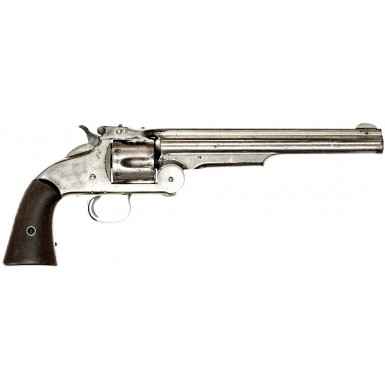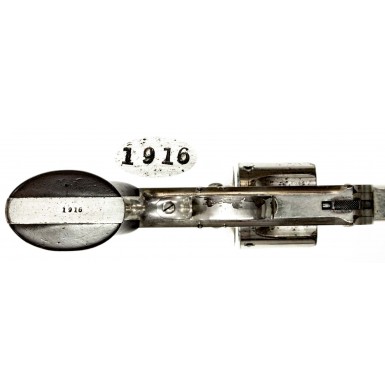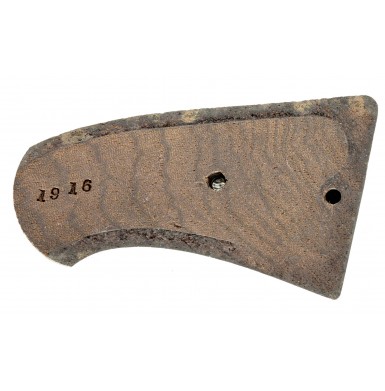Extremely Rare Nickel Smith & Wesson Martial #3 1st Model American - Only 200 Delivered in Nickel!
- Product Code: FHG-2317-SOLD
- Availability: Out Of Stock
-
$1.00
In 1870, Smith & Wesson introduced a new cartridge revolver that would become the basis for at least five other subsequent models, and which would remain in production in one form or another for some four decades. The Model # 3 First Model, which eventually received the moniker “American” was the prototypical large frame Smith & Wesson handgun of the old west period. The nickname originated to differentiate this variant of the Model #3 from a variant produced under contract for the Russian military. The revolver was chambered for the .44 S&W American cartridge, with less than 100 also manufactured in .44 Henry Rim Fire. The .44 S&W American cartridge was simply called the .44-100 when it was first introduced, but which had to be differentiated from the “Russian” variant of the .44 cartridge after that foreign contract was signed. The gun was a single action revolver with a six shot fluted cylinder and a ribbed round barrel that was usually 8-inches in length. Standard finishes were either blued or nickeled, with smooth two-piece walnut grips. Small parts like the trigger, extractor star and extractor release catch were blued, and the hammer was color casehardened, no matter which finish the revolver was delivered with. Sights were rudimentary at best with a small notched rear sight on the top of the barrel release catch and a round steel front sight blade pinned into a slot in the barrel rib. The revolver incorporated a number of “firsts” for the company. It was the first center fire revolver that Smith & Wesson produced. It was also the first .44 caliber handgun for the company, the first “large frame” handgun for Smith & Wesson, and most importantly the first gun to feature a tip down barrel with simultaneous extraction.
The revolver was originally designed for the 1870 US Ordnance Board handgun trials, where it performed well enough that a contract for 1,000 guns were received by the company on December 28, 1870. The deliveries made under this contract tool place in March of 1871. These “martial” #3 Americans appear to be somewhat evenly distributed within the serial range of 125 to 2199. One of the features that made the #3 so appealing to the Board was the “simultaneous” extraction system. By lifting a latch on the top of the frame the action of the revolver was opened and as the barrel was tipped down, a star extractor, powered by a ratchet mechanism, withdrew the cartridges from the cylinder, and expelled the empty cases. It was then an easy matter to replace any spent rounds, close the action and be ready to use the revolver again. By comparison, Colt’s competing design, the Single Action Army, released in 1873, required a slow system of manual extraction of each spent case one at a time, with an equally slow loading process.
The 1,000 guns that were delivered under the 1870 Ordnance Department contract were primarily delivered with blued finishes and the usual smooth, oil finished walnut grips. However, 200 of the guns were delivered with nickel finishes and these guns are very scarce today. All of the guns in the order were inspected by civilian sub-inspector Orville W. Ainsworth. Ainsworth had begun his Ordnance Department career as an employee of the Springfield Arsenal in about 1850, working as a “gunsmith”, “armorer” and “engineer” for several years before leaving the arsenal around 1859 and moving his family to New Haven, CT. With the outbreak of the Civil War and the need to inspect hundreds of thousands of contract arm, Ainsworth was enticed to return to government service as an arms inspector in 1861, initially to inspect arms produced by Colt. During the course of the war, he would also inspect arms produced by Sharps, Remington and LG&Y to name a few. After the war he remained an Ordnance Department employee and continued to inspect contract arms, among the most famous of which were many of the “Custer Era” Colt Single Action Army Revolvers. Ainsworth died in January of 18745 after an illness that developed in November of the preceding year. The Ainsworth inspected Smith & Wesson Model #3 revolvers were marked with his small capital A stamp on the lower left side of the frame below the cylinder, on the left side of the topstrap and in one of the cylinder flutes. He also applied his script OWAcartouche to the left grip. The guns were additionally marked with a US on the top of the barrel rib, perpendicular to the barrel address and near the frame end of the barrel. A similar style of US property mark would be applied to the frames of the Colt Model 1873 Revolvers that would replace the Smith & Wessons. The blued military inspected S&W #3 revolvers also received small capital P inspections on several parts, but these marks were not applied to the nickel finished guns.
The Smith & Wesson simultaneous extraction system would be so successful and popular that a number of Smith & Wesson models in multiple frame sizes and calibers would utilize it, well into the 20th century. The first 1,500 or so of the #3 American revolvers were manufactured with a tiny “oil hole” in the bottom of the barrel web, just in front of the frame hinge and ratchet system. This allowed for the ratchet mechanism to be lubricated. It was discovered that this was an unnecessary feature and was eliminated from standard production somewhere between serial numbers 1450 and 1537. In all, Smith & Wesson would produce about 8,000 Model # 3 “American” First Model revolvers between 1870 and 1872, when a refined version the “Second Model” American would replace it.
Many of the small design changes and improvements for the 2nd Model can be credited to changes requested by the Russian government, who had ordered some 20,000 #3 Revolvers in 1871. The initial successes of the #3 made the gun very popular in a number of circles. Major George W. Schofield of the 10th US Cavalry, one of the famous regiments of “Buffalo Soldiers”, was one of those people who had a great fondness for the Smith & Wesson design. In fact, Schofield was so impressed with the design that he arranged to act as a sales agent for Smith & Wesson. Schofield sold over 100 Smith & Wesson #3 American revolvers between the fall of 1870 and spring of 1871. Most of those guns were almost certainly sold to other cavalry officers, and as a result Schofield started to build a foundation of support for the Smith & Wesson design. Schofield suggested a number of improvements to make the revolver more user friendly for the cavalry, with the end results being the 1st Model Schofield and later the 2nd Model Schofield. Both of these guns were modified #3 American’s, chambered for the .45 S&W cartridge.
Other western luminaries were very fond of the large frame Smith & Wesson design, including William F. “Buffalo Bill” Cody and frontier lawman Wyatt Earp, who supposedly carried a #3 at the famous shootout at the “O.K. Corral”. Over the next four decades thousands of #3 variants would be produced, in a variety of calibers and some even fitted with shoulder stocks and long barrels as revolving rifles. The success of the design was resounding, and in the end the average frontiersman was about as likely to have a Smith & Wesson #3, or some variant thereof, in his holster as a Colt Single Action Army. All of that, however, started with the Smith & Wesson Model #3 1st Model American in 1870 and were it not for the initial Ordnance Department contract the design may not have been as successful as it was.
Offered here is a FINE condition example of a Smith & Wesson Model #3 1st Model American Martially Marked Revolver with the very scarce nickel finish. The gun is 100% complete and correct in every way and remains a very nice, unaltered example of an early large frame .44 Smith & Wesson military contract revolver. The revolver is serial number 1916, and that number is clearly stamped in the butt of the revolver. The serial number is also clearly stamped on the inside the right grip panel. The matching assembly mark I2 is found on the grip frame under the right grip panel, on the rear face of the cylinder and on the bottom of the latch that opens the action. The top of the 8-inch ribbed barrel is roll marked in a single line:
+SMITH & WESSON SPRINGFIELD MASS U.S.A. PAT. JULY 10. 60. JAN. 17. FEB. 17. JULY 11. 65 & AUG. 24. 69.+
The marking is flanked by a pair of Maltese Crosses, one at each end. At the end closest to the frame a clear US is stamped perpendicular to the barrel marking. Ainsworth’s inspection A marks are present in the correct places, on the left side of the topstrap above the cylinder, on the left side of the frame below the cylinder and in one of the cylinder flutes. The serial number is confirmed in the Springfield Research Service serial number books as one of the 1,000 Smith & Wesson revolvers delivered to the Ordnance Department in March of 1871. Interestingly #1917, the next serial number, was not part of the military delivery. The revolver is also verified by serial number as being one of the 200 guns delivered with a nickel finish, instead of the standard blue. According to research published by Jim Supica and Richard Nahas in their Standard Catalog of Smith & Wesson, all of the guns delivered to the military below serial number #1895 were blued, with the exception of four guns. The majority of the nickel finish guns are found in the serial number range #1895-#2199, all of which were nickel with the exception of four guns. Although that range covers more than 200 guns, not all of the guns between #1895 and #2199 were delivered to the military. However, those that were (with four exceptions) were all nickel finished. Obviously #1916 falls in this range of nickel plated military No 3 Revolvers.
The pistol is really in FINE condition and retains a large amount of its original nickel finish and has not been refinished. Overall, the gun retains about 80%+ of the original nickel, with the largest amount of loss being a thumb-sized patch on the right rear of the frame, where it has thinned and worn and appears to have been lightly cleaned long ago. The balance of the loss is the result of flaking and wear along the high edges and contact points. This is most noticeable at the muzzle, around the forcing cone and just forward of the cylinder on the barrel, flaked loss on the edges of the topstrap and along the leading edges of the cylinder and the front edges of the flutes. There is moderate loss on the backstrap as well from handling and use, and in this area much of the nickel has thinned or worn away. There is also a patch of tiny bubbling on the left side of the frame, behind the recoil shield. The areas where the nickel has flaked and worn have most developed a deeply oxidized brown patina and the result is a freckled appearance over the gun. There are some tiny areas of flaked loss along the barrel and rib as well, but these are minor and widely scattered. A turn line is also clearly present passing through the stop slots of the cylinder. The blued trigger retains about 50% thinning and fading blue and the ejector catch shows a similar amount of blue. The extractor star also retains some nice thinned and dulled blue finish. The hammer retains about 30%+ dulled and faded case colors with some visible mottling. The gun remains almost entirely smooth with only some lightly scattered traces of pinpricking present as well as some scattered patches and flecks of minor surface oxidation, which is most prevalent on the backstrap. The bore of the revolver is in about VERY GOOD condition and remains partly bright with crisp rifling. The bore shows a moderate amount of scattered oxidation as well as scattered pitting. The most noticeable areas of oxidation and pitting are found in the last few inches nearest the muzzle. All of the screw heads are in at least very good condition, with only a couple showing some light to moderate slot wear, and the balance appearing fairly crisp and relatively untouched. The original small rear sight is in place on the top of the frame latch, and the original steel half-moon front sight is correctly pinned into the barrel rib near the muzzle. The revolver is mechanically functional. The action performs crisply, and the gun remains extremely tight with flawless indexing and lock up. The automatic extraction system functions smoothly and correctly as well. The revolver locks up very tightly and the frame to barrel fit is excellent with no wobble or looseness. It is worth noting that the half-cock position of the hammer is a safety position that keeps the firing pin from contacting the cartridges. It does not retract the bolt stop or free the cylinder to rotate as would be the case of a gun that loaded and unloaded via a loading gate. The only mechanical issue worth noting is that that topstrap latch spring feels a little week, but it does not affect the operation the revolver of the gun in any way.
The two-piece, oil-finished walnut grips rate about NEAR VERY GOOD. They both are solid and complete with no breaks, cracks, chips or repairs. As noted, the right grip panel is correctly stamp-numbered to the revolver on its interior. Unfortunately, the grips have been sanded and this has removed the Ainsworth cartouche from the left grip. A small P inspection is still present on the bottom of the right grip, but no cartouche is present. The grips do show some additional wear and minor flattening to the sharp edges due to use, as well as some scattered handling marks.
Overall, this is a very nice and extremely scarce Smith & Wesson Model #3 1st Model American Nickel Finished US Military Revolver. These early production US military #3s are extremely desirable revolvers because they were the first official cartridge revolver adopted by the US military that was not an alteration from percussion. Their low production has also made them particularly desirable on the collector market. The gun is absolutely 100% complete and correct in every way, displays very well, has a fantastic “been there, done that” old west look, and remains mechanically fine. This is a wonderful piece of American military and western history and for an advanced Smith & Wesson collector this is one of those scarce guns, rarely found for sale. Rarely do these original nickel finish US military contract Model #3 revolvers come up for sale, and when they do, they rarely retain anywhere near this much finish. If this very high condition gun still had the Ainsworth cartouche it would be a five-figure gun, due to the rarity and condition. It may be a very long time before another nickel US military S&W #3 comes up for sale with this much finish, so don’t miss your chance to get an extremely rare US military revolver from the Indian War period, of which only 200 were delivered.
SOLD
Tags: Extremely, Rare, Nickel, Smith, &, Wesson, Martial, #3, 1st, Model, American, Only, 200, Delivered, in, Nickel!














